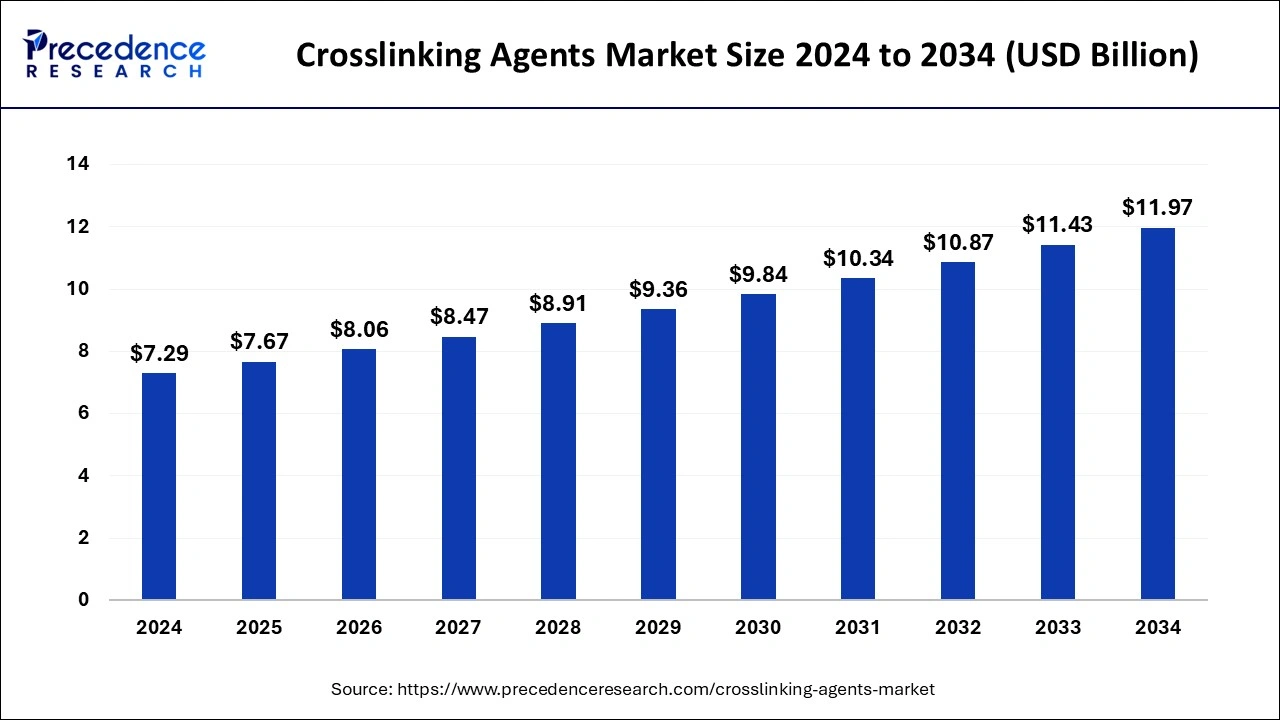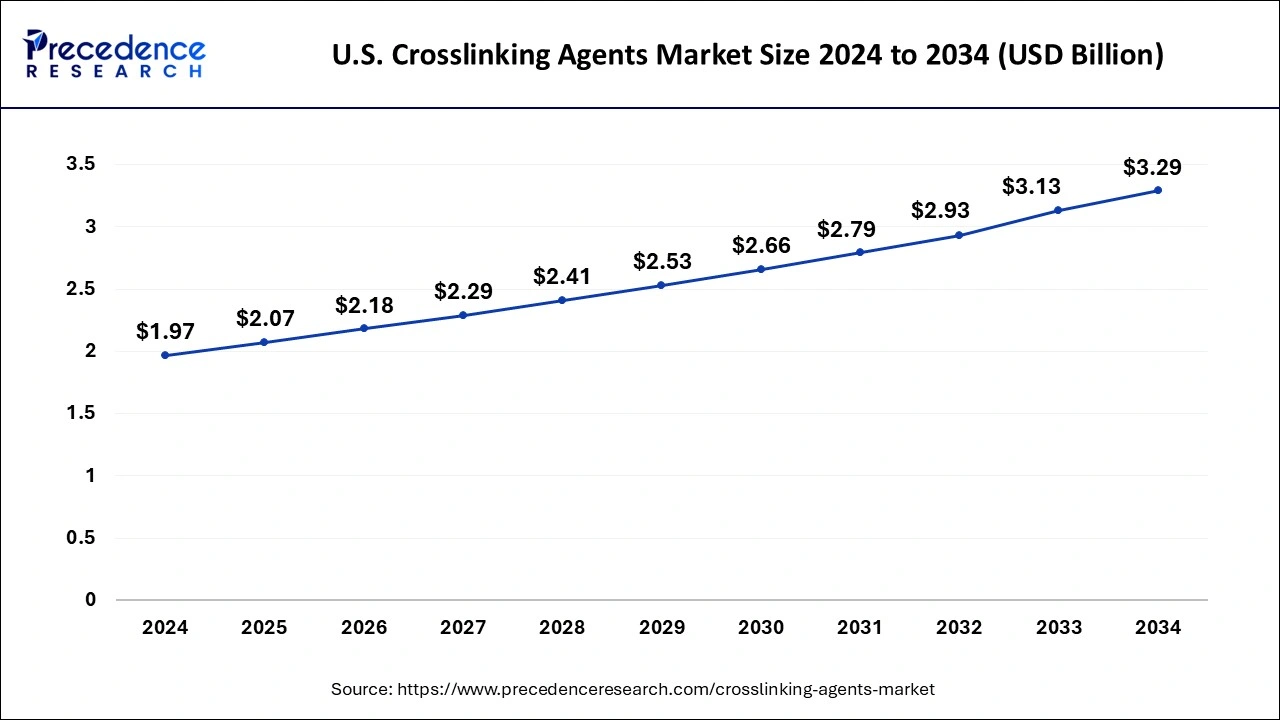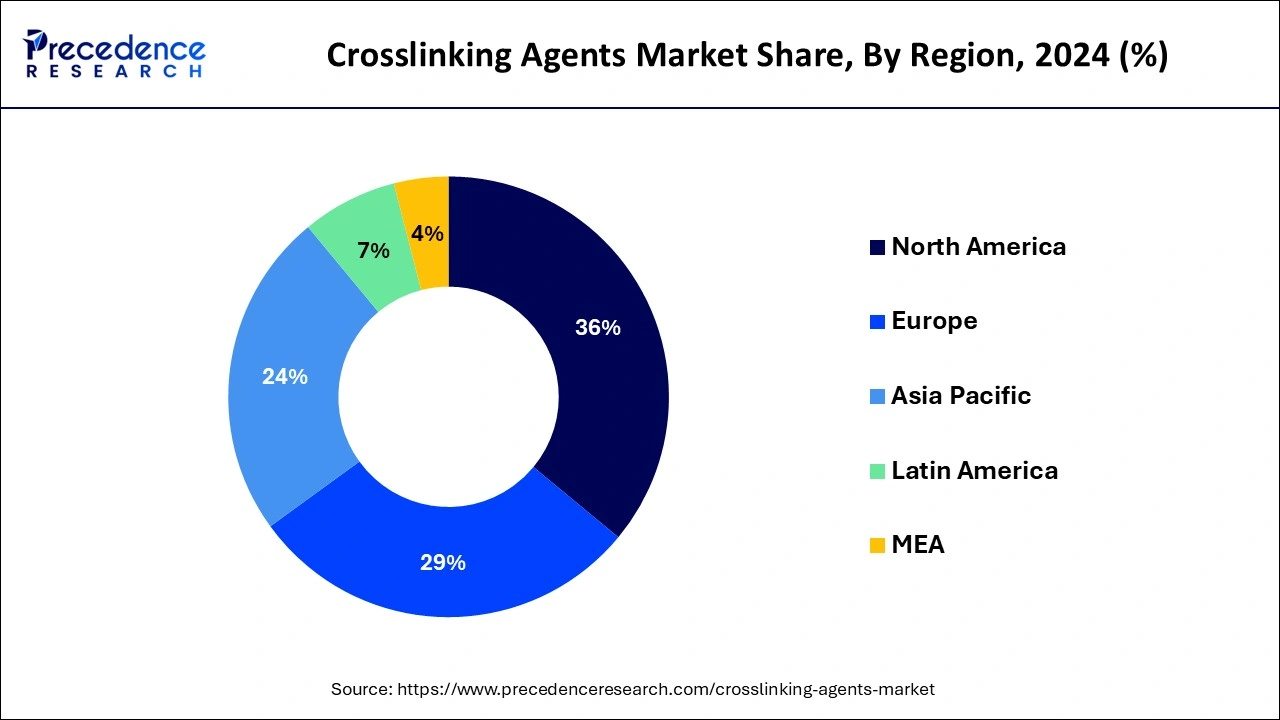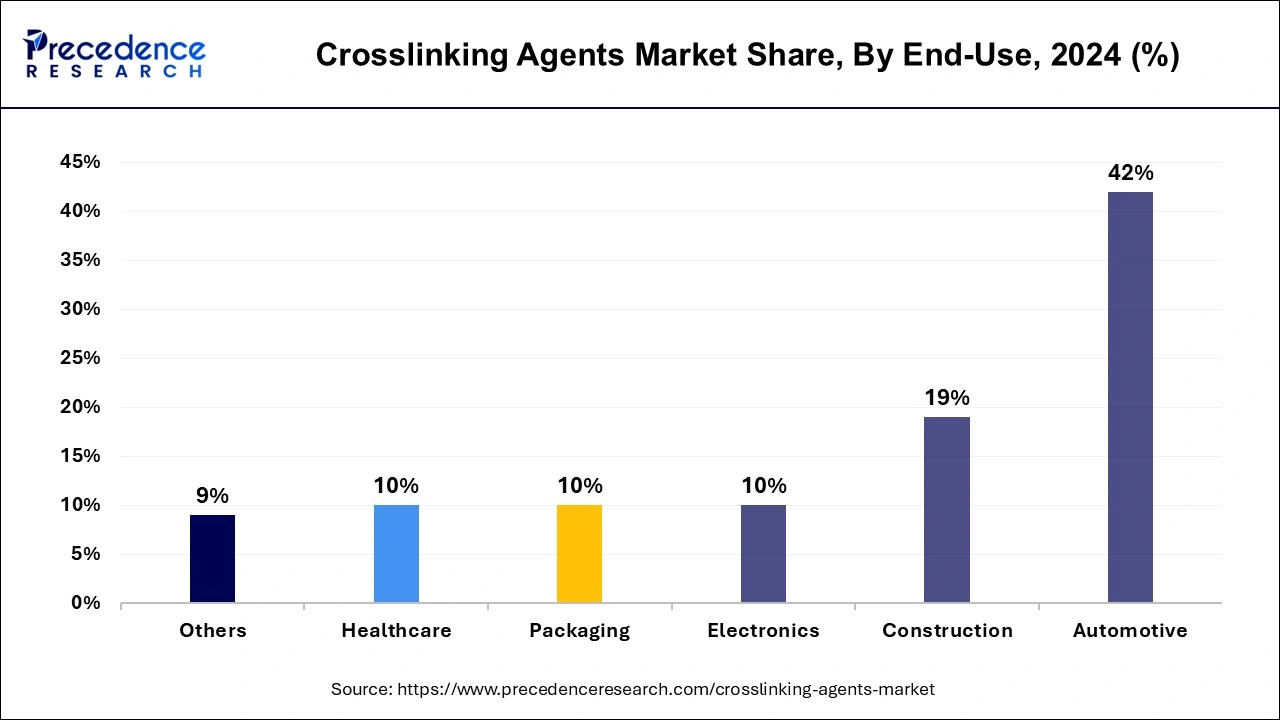August 2024
The global crosslinking agents market size is calculated at USD 7.67 billion in 2025 and is forecasted to reach around USD 11.97 billion by 2034, accelerating at a CAGR of 5.08% from 2025 to 2034. The North America crosslinking agents market size surpassed USD 2.62 billion in 2024 and is expanding at a CAGR of 5.11% during the forecast period. The market sizing and forecasts are revenue-based (USD Million/Billion), with 2024 as the base year.
The global crosslinking agents market size was estimated at USD 7.29 billion in 2024 and is predicted to increase from USD 7.67 billion in 2025 to approximately USD 11.97 billion by 2034, expanding at a CAGR of 5.08% from 2025 to 2034. Crosslinking agents improve the durability and performance of the automotive components which helps to the growth of the market.

The U.S. crosslinking agents market size was estimated at USD 1.97 billion in 2024 and is predicted to be worth around USD 3.29 billion by 2034 at a CAGR of 5.26% from 2025 to 2034.

North America dominated the crosslinking agents market in 2024. In North America, there is a high demand for crosslinking agents for various applications in different industries, including healthcare, packaging, electronics, construction, and automotive, which helps the growth of the market. The United States of the North American region is leading to market growth. In December 2023, the United States Food and Drug Administration of eCFR (Electronic Code of Federal Regulations) gave information about substances used as a component of coatings. The substances include crosslinking agents and catalysts for epoxy resins. Substances used for the coatings they recognized as safe in the food.

Asia Pacific is estimated to be the fastest-growing during the forecast period of 2025-2034. In the Asia Pacific region, natural crosslinking agents are highly used due to their having no negative effect on the environment or human safety. These factors help the growth of the crosslinking agents market. The major contributors to the growth of the market are India and China due to their larger population share. The higher population increases the demand for construction, which requires crosslinking agents. The Asia-Pacific area's growth is significantly influenced by China, the country with the largest economy in the region.
The development of the national economy is significantly influenced by a number of industries, including manufacturing, mining, building and construction, textiles, automotive, electrical and electronics, and medical and pharmaceutical. Mobile phones and computer accessories were the country's leading exports in 2021, closely followed by integrated circuits, textiles, clothing and accessories connected to textiles, and automatic data processing equipment and components.
The crosslinking agents market plays a pivotal role in numerous industries by providing essential additives that improve the properties of materials, contributing to improved performance and durability. Crosslinking agents are compounds or chemicals that facilitate the formation of covalent bonds between polymer chains within a material. Crosslinking agents are important additives in the plastic industry. The crosslinking agents affect the polymers' mechanical and physical properties.
The crosslinking process is irreversible. The crosslinking agents are based on the polymer's functional groups, like anhydride or amine groups. Different crosslinking agents are used in plastics like polyepoxide (epoxy), polyurethane (PU), polyvinyl chloride (PVC), polypropylene (PP), and polyethylene (PE). The crosslinking agent's applications include PE, wire and cable, pipe, foam, and medical applications. Crosslinking agents provide higher physical properties for long-term heat durability and resistance. These factors help to the growth of the market.
| Report Coverage | Details |
| Growth Rate from 2025 to 2034 | CAGR of 5.08% |
| Market Size in 2025 | USD 7.67 Billion |
| Market Size by 2034 | USD 11.97 Billion |
| Largest Market | North America |
| Base Year | 2024 |
| Forecast Period | 2025 to 2034 |
| Segments Covered | Type, End-use, and Regions |
| Regions Covered | North America, Europe, Asia-Pacific, Latin America, and Middle East & Africa |
Rising demand for industrial applications
Crosslinking agents are in high demand for different industrial applications, including coating, packaging, electronics, construction, and the automotive industry. By coating bonds of crosslinking agents, polymers are joined together. Crosslinking agents improve durability and increase the size of the polymers, and these properties of the polymers help increase the number of applications across industry and science. Polyurethane powder is highly used in the coating industry, architecture, and automotive industries. Applications also include metal, garden, and lawn. Crosslinking agents like polyurethane powder coatings provide superior durability or light stability, antigraffiti properties, good flexibility, high hardness, good leveling, and chemical resistance.
In the automotive industry, these are used to protect the parts from degradation from chemical attacks, including brake fluids or acid rain, and they are stone chip and UV resistant. In household appliances, crosslinking agents are used to coat them to improve their appearance and chemical resistance properties. These have good mechanical and chemical & weathering resistance properties, and these are suitable for various industrial appliances. It helps to improve the lifespan of industrial products. These factors help to the growth of the crosslinking agents market.
Disadvantages of the cross-linked agents
Some cross-linked agents like polysaccharides have some disadvantages, like limited solubility in specific solvents, instability in the body’s fluid system, and poor mechanical properties. Protein-based hydrogels used in the medical industry have some disadvantages, including rapid degradation and mechanical instability. The main disadvantage of collagen is that it has insufficient thrombogenic and mechanical properties because of the degradation process. Gelatin is used in capsules, tissue engineering, and drug delivery systems, but its disadvantages include insufficient mechanical and low thermal stability properties. Disadvantages in natural crosslinking agents include a lack of repeatability of the raw material and higher production costs. The disadvantages of synthetic crosslinking agents include the fact that they are obtained from chemical reactions, are harmful to the environment, cause oxidative stress induction, and cause cytotoxicity. These disadvantageous factors may restrict the growth of the crosslinking agents market.
Rising demand for natural crosslinking agents
The natural crosslinking agents include vanillin, epigallocatechin gallate, tannic acid, citric acid, and genipin, which are used in industries such as cosmetics, biomedical, and pharmaceutical. Bio-crosslinking agents or plant-based crosslinking agents are obtained from natural resources, which reduces the toxic effects and is helpful to the environment and human safety. Natural crosslinking agents are used because of their bio functionality of the derivative products, lack of negative effects on the environment, and low cost of raw materials.
It does not require a purification stage during product formation. These natural crosslinking agents are used as alternatives for synthetic crosslinking agents. Natural crosslinking agents like polymers are highly used as macromolecular compounds for the preparation of hydrogels for biomedical, medical, and biosensing applications. Natural crosslinking agents help to make highly biocompatible and stable cross-linked hydrogel materials. These natural crosslinking agents have lower cytotoxicity, or in some cases, they are non-cytotoxic in the crosslinking reactions. These factors of natural crosslinking agents have the opportunity to grow in the crosslinking agent market.
Research and development
To overcome the disadvantages of natural crosslinking agents, like higher production costs and lack of repeatability of the raw material development or investment in natural crosslinking agents, is necessary. To overcome the disadvantages of synthetic crosslinking agents, such as negative effects on the environment, cytotoxicity, and chemical reactions, innovations can be developed by using new methods. These factors help to the growth of the crosslinking agents market.
The amide-based crosslinking type segment dominated the market in 2024. Amide-based crosslinking agents have many advantages, mainly in biomedical applications. In the production of nanogels amide, crosslinking reactions take place because of the formation of amide bonds, which have more stability. Amide-based crosslinking acts as a nanocarrier for drug delivery. Ester bonds may be hydrolyzed to release drug molecules, but amide-based crosslinking agents are also used due to the simplicity of drug delivery. Amide-based bonds are also called peptide bonds. Amide group type of functional group or amide-based crosslinking agents is used in many areas, including bioengineering, chemistry, and pharmacy, such as biochemistry, polymers, drug discovery, and chemical synthesis. In the biomolecule composition, amide-based crosslinking is important, and it includes many therapeutically approved drugs. These factors help the growth of the amide-based crosslinking agents segment and contribute to the growth of the crosslinking agents market.
The isocyanate-based crosslinking agent's type segment is the fastest-growing during the forecast period. Isocyanate-based crosslinking agents are highly used in many applications. These types of isocyanate-based polymers or crosslinking agents include copolymers, polyisocyanurates, polyureas, and polyurethanes. These isocyanates are used in the markets and include insulation foam, elastomers, sealants, adhesives, furniture, clothing fibers, rubber process equipment, thermoplastics equipment, and coatings for the automotive and construction industries. Isocyanates are used as crosslinking agents in the preparation of microcapsules by simple interfacial polymerization or in-situ polymerization. These are also used in wood adhesives for furniture using plant-based castor oil to modify the water-dispersible isocyanate, which is used as a crosslinking agent. In silica aerosol monoliths, isocyanate-based crosslinking agents are used. These factors help the growth of the isocyanate-based crosslinking agents type segment and contribute to the growth of the crosslinking agents market.
The automotive segment led the crosslinking agents market in 2024. The segment is observed to sustain the position throughout the forecast period. The automotive sector is subject to strict environmental and safety standards. Crosslinking agents help manufacturers comply with these regulations by improving the properties of coatings, such as reducing VOC (Volatile Organic Compound) emissions and enhancing the fire resistance of materials used in vehicles.

The automotive industry requires high-performance coatings and materials that can withstand harsh environmental conditions, such as extreme temperatures, UV exposure, and mechanical wear. Crosslinking agents enhance the durability, chemical resistance, and overall performance of automotive coatings and adhesives.
By Type
By End-use
By Geography
For inquiries regarding discounts, bulk purchases, or customization requests, please contact us at sales@precedenceresearch.com
No cookie-cutter, only authentic analysis – take the 1st step to become a Precedence Research client
August 2024
May 2024
July 2024
August 2024